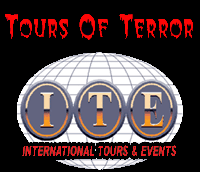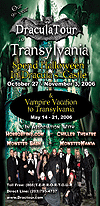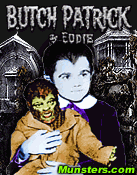
Photo credits: Kathleen Fegan, Laurie Sherman, Karen Simone, Sarah B. and "Photo" Joe Schifferdecker
'We're Vlad We Went!'
~ Francis Ford Coppola's Bram Stoker's Dracula.
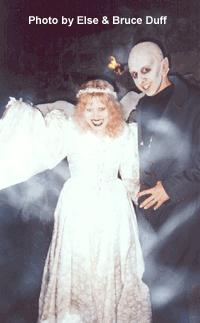
Well, that's not quite true. Sunday, 28 October 2001, was actually a beautiful day, with relatively few clouds in the sky. And night, by its very nature, is inherently dark.
Still, there was something in the air... an intangible aura of electricity, of excitement, of anticipation. It swirled around our small group as we waited outside the Lufthansa ticket counter for the rest of our fellow travelers to join us, touching each person there, shouting silently of the fun that awaited us on the other side of the Atlantic.
Shortly, all those who were about to embark on this eight-day journey to Dracula's homeland had arrived. We all were introduced to Danny and Charles of 'Tours of Terror', the organizers of the tour. Charles was going to be making the trip with us this year; Danny will be going again in 2002. Both gentlemen impressed me with their interest in the horror genre in general, with their knowledge of Dracula lore in particular, and with their obvious passion for this tour they had devised.They greeted us with gifts including horror magazines and beverages appropriate for the trip: 'DraCola' and 'Dracula Energy Drink.'
We arrived at the Bucharest airport and met the native members of our tour; our guide, Radu, and our driver, Stephan. Charles and Radu encouraged us to exchange currency in the airport, as future opportunities to do so might not offer as favorable an exchange rate. Once all of the luggage had been gathered and we had boarded the bus, we set off for our first destination: Brasov. Most of us slept on the bus to the background tapes that had been provided by Loretta from the first DraculaTour! We stayed in the Hotel Aro Palace, one of the finest hotels in all of Brasov. The hotel was quite an example of old-world elegance, from the large and open lobby to the nicely appointed restaurant. The lobby was large enough to house a football field, or to film a movie (can anyone say 'The Shining'?). Once in our rooms, we had gorgeous views, but, for some of us, the balcony doors were locked. Was that to keep us in? Or to keep certain strangers out.
Even though we had been warned that Romanian toilet paper was rougher than its American counterpart, no amount of forewarning or coaching could have prepared us for the truth. If you want to experience for yourself firsthand what Romanian toilet paper is like, go to any party store and buy a role of crepe paper, pull off a hunk, and use that. It was amazingly stretchy stuff and not perforated at all, but it did manage to, ahem, get the job done. Several of the more craft-oriented among us actually brought some Romanian toilet paper home for use in various projects. I guarantee you that no one who sees an item made with this material would ever guess its true origins.
After we checked in to our rooms and had a short time to relax and freshen up, we gathered in the restaurant for dinner. Overall, I found our dinners to be the best meals we had on this trip. Most restaurants offered a good selection of pork dishes, a number of chicken dishes, but only a few beef entrees. Bread or rolls were usually provided, but butter was an extra item on the menu that needed to be ordered. In the restaurant there was a pleasant three-piece band that played standards from Sinatra to Clapton. They obviously knew we were Westerners.
The nice part of this first dinner was getting the opportunity to chat with some of our fellow tour members.
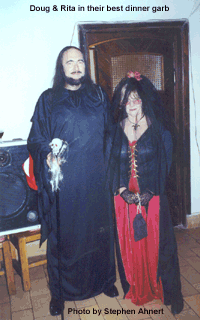 My wife, Eileen, and I had dinner this first night with Phil and Beth, adult siblings from Florida. It was nice to talk about our various interests, what we hoped to see on the tour, what we did back home, and so forth. Sadly, a midnight tour of a nearby cemetery with a sťance was canceled due to rain. Several members of our group decided to go out on their own and explore a different sort of nightlife. Eight or so valiant (and awake!) made their way to a club. Although it wasnít anything like the Mexican nightclub in the movie 'From Dusk Till Dawn', it was nonetheless a memorable night. There were definitely some party animals in this group.
My wife, Eileen, and I had dinner this first night with Phil and Beth, adult siblings from Florida. It was nice to talk about our various interests, what we hoped to see on the tour, what we did back home, and so forth. Sadly, a midnight tour of a nearby cemetery with a sťance was canceled due to rain. Several members of our group decided to go out on their own and explore a different sort of nightlife. Eight or so valiant (and awake!) made their way to a club. Although it wasnít anything like the Mexican nightclub in the movie 'From Dusk Till Dawn', it was nonetheless a memorable night. There were definitely some party animals in this group.Howling wolves could not wake us, but the hotelís wake-up call did the trick. We emerged from our rooms on our first morning in Romania and made our way down to the restaurant for breakfast.
Our first stop for the day was the town of Bran where we were to visit Bran Castle. The castle itself is situated atop a small hill and was originally built in the late 14th century to help defend the area against the Turks. Contrary to popular belief, this castle was not built by Vlad Tepes, although he was imprisoned there for some time. We got an extensive history of the region, of Vladís legacy and learned a great deal about Transylvania, 'the land beyond the forests', from Radu. Walking through Bran Castle, I was impressed by a number of things. I found the architecture to be marvelous. The castle is being restored, but it was still in a remarkable state of repair, even owing to the relatively recent addition of electric lights to the facility. We went through almost every place above-ground in the castle; I don't know if there was any way to tour the extensive underground passages, but it would have been interesting to see them. Of course, if these passages were anything like the "Secret Staircase" we climbed, I'm not positive I would have been able to navigate through them, as I am 6'6" tall. The Secret Staircase was extremely steep and narrow; both of my shoulders were brushing the sides of the passage as I ascended. I also noticed that many doorways were rather short, which made sense... there was little to be gained by making the doorways any larger than absolutely necessary for one person to pass through; the smaller they were, the easier they would be to defend.
At the base of the castle was an open-air bazaar. It was here that we found the wonderful buys that previous tour reports have raved about. Many of the vendors sold what appeared to be hand-made wool sweaters, and these garments could be purchased for an incredibly low price compared to what similar sweaters would cost here. The vendors offered other handcrafted items, such as plaques and woodcarvings, as well as more tourist-oriented items, such as t-shirts, banners, and pictures. We could easily have spent much more time at the bazaar.
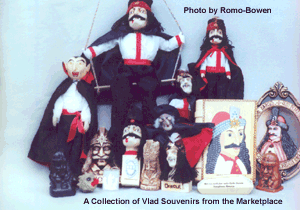 We headed back to Brasov for lunch and a bit of wandering. Our time there was rather limited, though, as we had a long drive ahead of us. We took a quick jaunt through the town by bus and Radu pointed out some of the more famous (or infamous) landmarks.
We headed back to Brasov for lunch and a bit of wandering. Our time there was rather limited, though, as we had a long drive ahead of us. We took a quick jaunt through the town by bus and Radu pointed out some of the more famous (or infamous) landmarks.Our next stop on the tour was the town of Bistrita, some five-plus hours away from Brasov. To help the time pass more quickly, Charles and Radu fired up the on-bus VCR and we watched the 1931 version of "Dracula". Some might consider this the only version, but I'm a bit more open-minded than that. Following the movie, Charles slipped on his "tour director" hat and told us a bit about himself. Then, starting at the front of the bus, he had everyone on the tour introduce themselves as well, using the thinly-veiled ruse of "letting the bride and groom know who would be attending their wedding."
Wedding? Did I forget to mention that two brave and intrepid souls were taking this tour as part of their wedding ceremony? Yes, Chuck and Tina were to be married on Hallowe'en as we partied the night away at the Hotel Castel Dracula, high atop the Tihuta Pass. Having a wedding occur as part of the tour was a first for Charles, but I suspect that it won't be the last, especially for those couples who enjoy the macabre.
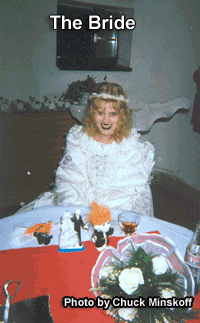 As person after person made his or her introductions, Charles would add a comment or two to keep us all in high spirits, even suggesting several people who could perform roles in the wedding ceremony. When it was my turn to make my introduction, Charles interrupted me to proudly announce that I was the winner of the first DraculaTour trip giveaway that had ever been done. I had entered a contest at www.horrorfind.com and, of all the people who entered, my name was drawn for their "Ultimate Grand Prize"... a trip for two to Transylvania. Once again, I extend my most heartfelt and humble thanks to Charles and Danny of Tours of Terror and to Mike Roden of HorrorFind.com. Guys, this vacation was something Eileen and I will remember for the rest of our lives. But I digress.
As person after person made his or her introductions, Charles would add a comment or two to keep us all in high spirits, even suggesting several people who could perform roles in the wedding ceremony. When it was my turn to make my introduction, Charles interrupted me to proudly announce that I was the winner of the first DraculaTour trip giveaway that had ever been done. I had entered a contest at www.horrorfind.com and, of all the people who entered, my name was drawn for their "Ultimate Grand Prize"... a trip for two to Transylvania. Once again, I extend my most heartfelt and humble thanks to Charles and Danny of Tours of Terror and to Mike Roden of HorrorFind.com. Guys, this vacation was something Eileen and I will remember for the rest of our lives. But I digress.After we'd all made our introductions to the bride and groom, Charles began his infamous "Penny Auction". He'd brought a number of horrorble items to auction off, some more collectable than others, and everyone quickly got into the spirit of the event.
After this, we watched the original "Nosferatu" (1922), which ended just as we pulled in to the next stop on our destination, the town of Bistrita. We checked in to the hotel and headed to our room. Most of the group were up for late-night fun, and actually visited
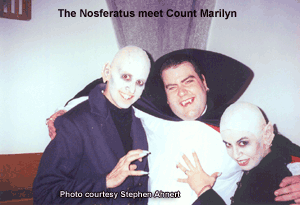 a go-go bar. This was an official, albeit impromptu bachelor party for our groom-to-be, Chuck, but he behaved like a total gentleman and managed to resist all temptations.
a go-go bar. This was an official, albeit impromptu bachelor party for our groom-to-be, Chuck, but he behaved like a total gentleman and managed to resist all temptations.Rumor has it that it was quite a wild night, with some from our group even dancing with strippers on stage. The rules of most strip clubs in the US donít apply here and the dancers had no problem showing patrons a good time. This was a definite plus for the single men on the tour.
The schedule for Day Four allowed some of us to sleep in late. That gave others the morning to wander around Bistrita to look for deals on souvenirs. After two rather cool days and some drizzling, today was simply beautiful.
At noon, we boarded the bus and headed off for the famed "Hotel Coroana de Aur," or "Golden Crown Hotel," for lunch in the "Jonathan Harker Salon." The hotel did not exist in Bram Stoker's time, even though he placed Harker there; the hotel was built subsequent to the release of "Dracula" to capitalize on the book's popularity. The "Jonathan Harker Salon" was created to cater to tourists who wished to "follow in Harker's footsteps." Costumed in appropriate cloaks, the waiters greeted us with a blood-red elixir. They also served our meal that afternoon, which was based in part on what Harker was served, robber steak, which turned out to be
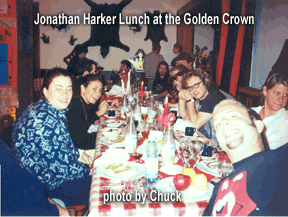 skewered cubes of pork, beef, small sections of sausage, onion, and green pepper. That was not all we were served, of course; the actual lunch consisted of six or seven courses, starting with a small snifter of the aforementioned "Dracula Zaubertrank" or "Dracula Elixir," a very strong, very red plum brandy. The restaurant was decorated with a number of stylish Dracula-themed paintings, as well as with the more traditional menagerie of stuffed and mounted birds, wild game, and even what appeared to be a very put-out housecat. It was an interesting and entertaining meal; I especially enjoyed watching the candle nearest us ignite its candlestick decoration, creating a ball of flame nearly a foot high -- and many people posed in the Dracula garb that was provided to us. All through lunch, in what was at times hilarious and ridiculous, each member of the tour was called upon to deliver a toast. Many chose to toast the bride and groom-to-be, and by this time everyone in the group was getting to know one another pretty well. One of the quietest members of the group, Marianne, ended the toasting with 'a toast to the end of the toasts.' No pieces of toast were thrown (thatís a Rocky Horror reference). The afternoon was a blast, the food was superb but the spirits were better.
skewered cubes of pork, beef, small sections of sausage, onion, and green pepper. That was not all we were served, of course; the actual lunch consisted of six or seven courses, starting with a small snifter of the aforementioned "Dracula Zaubertrank" or "Dracula Elixir," a very strong, very red plum brandy. The restaurant was decorated with a number of stylish Dracula-themed paintings, as well as with the more traditional menagerie of stuffed and mounted birds, wild game, and even what appeared to be a very put-out housecat. It was an interesting and entertaining meal; I especially enjoyed watching the candle nearest us ignite its candlestick decoration, creating a ball of flame nearly a foot high -- and many people posed in the Dracula garb that was provided to us. All through lunch, in what was at times hilarious and ridiculous, each member of the tour was called upon to deliver a toast. Many chose to toast the bride and groom-to-be, and by this time everyone in the group was getting to know one another pretty well. One of the quietest members of the group, Marianne, ended the toasting with 'a toast to the end of the toasts.' No pieces of toast were thrown (thatís a Rocky Horror reference). The afternoon was a blast, the food was superb but the spirits were better.Our lunch had barely begun to digest before we got back onto the bus and returned to the hotel, something most everyone was anticipating. Why? Because we were to spend the next three hours getting ready for that evening's costume party, and weddingat the Hotel Castel Dracula. Some people needed only a short time to prepare, while others of us needed the full three hours (and probably could have used a couple more hours as well).
Ah, Hallowe'en in Transylvania. For a true Hallowe'en buff, Dracula fan, or Master of the Macabre, there really isn't anything else quite like it. But, for most Romanians, October 31st isn't all that special a day. They don't really celebrate Hallowe'en, at least, not in the way we do. In fact, most Hallowe'en decorations that we saw were actually displayed for the benefit of "the American tourists" visiting the area, not for the locals. Therefore, our group certainly received more than our fair share of looks, stares, disapproving glances, and heads shaking in disbelief as we made our way out to the bus for the drive from Bistrita to the Tihuta (formerly Borgo) Pass and the Hotel Castel Dracula. We watched most of "Return of the Vampire" as we drove along, our way lit by both the headlights of the bus and by the rare full Hallowe'en moon (a VERY special treat, I assure you). While we watched the movie, I overheard a number of people talking about the hotel and wondering why, at the last minute, we were unable to stay over at the Hotel Castel Dracula. Apparently, the Dracula Society reserved the entire hotel, thus allowing them to dictate to the staff exactly what they did and didnít want. Allegedly, although they only used about 20 of the rooms, they didnít want any other groups staying with them. This even caused a great deal of unnecessary grief to Chuck and Tina, who arrived to find that their long-booked reservation "could not be found." It was only after Tina practically had a nervous breakdown that the hotel staff "found" their fourteen-month-old reservation. I personally believed they felt threatened by the tour and were actually afraid of the competition. If this is true, it is a testament to the success and quality of Charles and Danny's tour.
From reading the previous tour reports, as well as reading what little was printed in the tour books on the Hotel Castel Dracula, a fine evening was in store. Plus, we all had the wedding to attend.
The highlight of the evening was most certainly Chuck and Tina's wedding. These two had been planning this for fourteen-plus months, and, even with all that planning, much of it was left up to chance. They took a big gamble that those of us on the tour who were not part of their actual wedding party would be both like-minded enough and open-minded enough to appreciate a wedding in the middle of their Hallowe'en party. Fortunately, their gamble paid off. Everyone on the tour seemed to be supportive of Chuck's and Tina's plans, and I know that many of us were honored to be part of their union.
Upon arrival at Castel Dracula, we gathered in the brick-floored atrium for a group photo of all of us in costume. Nearly everyone really planned their costumes well, and some couldnít even be recognized. We were escorted into our private party room, which had been decorated with cobwebs, candles and plastic spiders. The atmosphere was perfect.
The wedding itself was anything but what one would consider typical. Tina entered the room to the eerie, gothic strains of "The Wedding March" played on an organ; a priest from a nearby monastery, who spoke no English, performed a traditional Romanian wedding; three Romanian nuns sang a traditional wedding blessing; Chuck and Tina exchanged their own personal vows; Charles offered his blessings to the happy couple, even providing a glass for Chuck to crush in the Jewish wedding tradition. All these disparate traditions and beliefs came together, though, and made for a moving ceremony, and I felt honored to be in attendance.
Even though there were a couple of changes to the eveningís agenda (presumably by the Dracula Society) that were slightly disappointing, nothing could have ruined the fantastic night we were having. Not even the local DJ who couldn't quite understand why no one wanted to listen to his seemingly exhaustive collection of Cher songs (he was particularly fond of "Gypsies, Tramps, and Thieves," which he kept trying to play after every third or fourth song). Luckily, Charles, being a DJ himself, began a pretty strict supervision of the music, and the selections greatly improved (there was a rumor floating about that Charles grabbed the local DJ's Cher CD and scratched it into unrecoverable unplayability, but that has yet to be confirmed).
For me, the real highlight of the evening... outside of the wedding, of course, came from seeing the magnificent costumes we all wore. This group collectively rose to the challenge, presenting some of the most creative, imaginative, wonderful costumes that I have seen in ages. We had a plethora of vampires milling about, as would befit any Dracula Tour. Vampire victims were popular as well. Various other undead creatures joined with their vampire brethren. Quasimodo put in an appearance, as did a couple of Grim Reapers and numerous Goth-inspired denizens of the night. Gomez, Morticia & Wednesday Addams were on hand for the festivities, as was Erik, the Phantom of the Opera, and the love of his life, Christine. A Cheerleader from Hell was on hand to shake her pom-poms and lead cheers. And, most impressively, a pair of Nosferatu-style vampires moved eerily through the crowd, their blue veins showing through the pale translucency of their bald heads and skin.
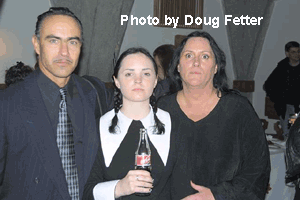 Looking at all of the amazing costumes, I felt slightly sorry for Charles, as it was going to be difficult to pick one winner for the various costume categories. But, pick them he did (with some able assistance from Eileen and Rita). Stephen was chosen as 'Best Dracula'. The Fanning family was chosen as the 'Best Ensemble' for their dead-on recreation of The Addams Family. When he got to the category of 'Best Transformation,' Charles wound up declaring it a tie between Doug and Christine since we all had difficulty recognizing either of them. I was quite surprised (and flattered!) to hear that Charles picked me for 'Scariest Costume' as Erik, the Phantom of the Opera, in his Masque of the Red Death costume. There was no doubt who won 'Sexiest Costume' -- Else as Cheerleader from Hell. And, without a doubt, the 'Best Overall Costume' award went to Robert and Mireya from California for their incredible transformation into the Nosferatu couple.
Looking at all of the amazing costumes, I felt slightly sorry for Charles, as it was going to be difficult to pick one winner for the various costume categories. But, pick them he did (with some able assistance from Eileen and Rita). Stephen was chosen as 'Best Dracula'. The Fanning family was chosen as the 'Best Ensemble' for their dead-on recreation of The Addams Family. When he got to the category of 'Best Transformation,' Charles wound up declaring it a tie between Doug and Christine since we all had difficulty recognizing either of them. I was quite surprised (and flattered!) to hear that Charles picked me for 'Scariest Costume' as Erik, the Phantom of the Opera, in his Masque of the Red Death costume. There was no doubt who won 'Sexiest Costume' -- Else as Cheerleader from Hell. And, without a doubt, the 'Best Overall Costume' award went to Robert and Mireya from California for their incredible transformation into the Nosferatu couple.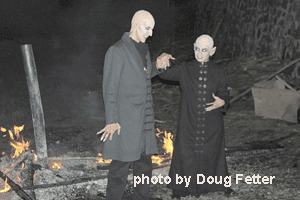 Members of the local press and Swiss television were on hand to capture the festivities, taking what seemed to be hundreds of shots of all of us in costume, using both still and video cameras. It was an amazing bonus to find, two days after the party, that a full-color photo of Robert and Mireya was printed in the Romanian paper, even if they did refer to us as a group of "crazy Americans." If the fun we had on Hallowe'en represented crazy, then I'm not certain I'd want to be sane.
Members of the local press and Swiss television were on hand to capture the festivities, taking what seemed to be hundreds of shots of all of us in costume, using both still and video cameras. It was an amazing bonus to find, two days after the party, that a full-color photo of Robert and Mireya was printed in the Romanian paper, even if they did refer to us as a group of "crazy Americans." If the fun we had on Hallowe'en represented crazy, then I'm not certain I'd want to be sane.Most of us went outside to the bonfire where we participated in an unusual ritual: leaping over the flames to prove our fearlessness (after all, shouldnít both a vampire or a vampire-slayer be fearless?). It was hysterical watching some of us in our more elaborate costumes make the jump. Fortunately, none of us wound up aflame. The Dracula Society was also in attendance at the bon fire. No one was aware at the time that they were the reason we couldnít stay at the hotel this year as the group did in the past, and I donít think it would have mattered if we did. Everyone was festive and celebrating the greatest night of all. Besides, we got our retribution when most of their group ended up as guests at OUR party. We were as wild and as fun as our costumes.
We were greeted on the fifth day of our tour to a somewhat overcast and hazy sky, but that cleared. The first order of business for the day was to travel back up to the Tihuta Pass and the Hotel Castel Dracula to pick up Chuck and Tina, who, by prior arrangement, had secured the bridal suite. It was not mandatory that everyone travel back to the hotel that morning, as the bus would return to Bistrita to pick up everyone else, but a few of us wanted to see what the Tihuta Pass and the hotel looked like in daylight
Driving through Bistrita, I was struck by the number of street vendors selling flowers. In some places, there was hardly any curb or sidewalk visible. Radu explained that November 1st, All Saint's Day, was a national day of recognition in Romania, as was November 2nd, which is All Soulís Day. People bought flowers to place them on the graves of their family, friends, and even strangers. It would be the exception, rather than the norm, to see a grave without some kind of flower or plant on it for the next few days.
When we arrived at the hotel, Radu told us we would have around twenty minutes or so to look around and take pictures. There was a small bazaar outside... only four or five booths really... which some of our group visited. I instead chose to visit a very small graveyard that was barely one hundred yards from the hotel. As Radu had mentioned, I found most of the graves to be decorated with flowers.
We returned to Bistrita to pick up the rest of our group; from there, we were off to Sighisoara, Vlad Dracula's birthplace. The center of Sighisoara is a well-preserved example of medieval architecture and life, with a tremendous clock tower serving as the most prominent
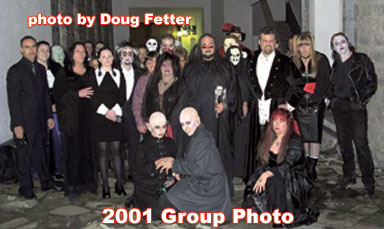 landmark. We were able to climb up the tower and walk around its perimeter, which provided an incredible view of the town. The buildings were all tall and narrow, pressing in against one another, practically forming miniature fortresses.
landmark. We were able to climb up the tower and walk around its perimeter, which provided an incredible view of the town. The buildings were all tall and narrow, pressing in against one another, practically forming miniature fortresses.Under the clock tower and just off to one side was the Torture Room Museum. The museum consisted of two very small rooms, the larger of which was no more than ten feet square, but with a very high, very black ceiling. The color, it was explained to us, came from soot from the fires built in the room to torture prisoners. Near a small trap door in the wall opposite the main door, Radu pointed out several faint carvings in the brick. One inscription he translated for us said something to the effect of, "I fear today is my last day on earth." Even though we'd been surrounded by history all week, it was the sight of this torture room that drove home to me the fact that we were looking at places where atrocities we had only heretofore read about were actually carried out on a daily basis. There is a tendency to romanticize the past, to make it seem more idyllic than it really was; places like the torture room serve to stand as a stark reminder that "the good old days" weren't always so good.
On the opposite side of the citadel from the torture room stood the Church of the Dominican Monastery, a massive building that, unfortunately, was not part of our tour. Charles did tell us, though, that the area in front of the church where a wide sidewalk now ran used to be a cemetery of unmarked graves. During the first Dracula Tour, this area had been dug up in preparation for the construction of the sidewalk and actual bones were scattered everywhere. The locals, being quite superstitious, would not touch the bones, so they just lay about in small piles. Charles and Danny, though, gathered up a bag full of bones and brought them home. I was mistaken in my thinking that these guys were 'normal'.
After we toured the torture room, a small performance had been arranged for us. A local group of actors put on a recreation of a witch trial (all in Romanian, of course, with a helpful translation provided by Radu), which started off back in the torture room. There, on a rack, hung "the witch," who was already quite bloody and bruised. They were trying to force a confession from her and were using various means so to do, including flogging her (quite realistically, I might add) and tightening the rack's winch. Finally, she confessed to her crimes -- more likely, she simply told the inquisitors whatever they wanted to hear just so they'd stop beating her -- and she was dragged back to the street outside of the clock tower where a judge was to decide her fate. Just as he was about to sentence her to death, a local man stepped forward and offered to marry her, thereby saving her from her fate. All in all, the presentation was very interesting; although I didn't understand one word of it, Radu explained the gist of the proceedings to us, and even that wasn't really necessary, as the actors' body languages and actions told the story without the need for words. This was the first time (but surely not the last) that the mock witch trial was a part of the tour.
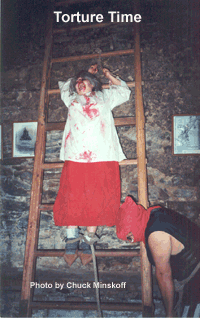 Following the trial, we broke for a bit to shop, explore on our own, or eat. There were only a couple of shops still open at the time, so most people opted to eat. We first tried to get a seat in the Dracul House restaurant, the actual birthplace of Vlad Dracula, but the small room we entered was nearly full and a rather rude woman actually closed the door in our faces! Not really wanting to walk down the hill to a pizza place, we spoke with Radu and Charles, who immediately went into the restaurant to figure out what had happened. As it turned out, the room we'd tried to enter was only one of five rooms in the restaurant, so there was plenty of space for us all to sit and get some dinner. There, some of us tried to get the waiters to sell us their rather unique, gothic vests, but to no avail (next year weíll offer them more money!).
Following the trial, we broke for a bit to shop, explore on our own, or eat. There were only a couple of shops still open at the time, so most people opted to eat. We first tried to get a seat in the Dracul House restaurant, the actual birthplace of Vlad Dracula, but the small room we entered was nearly full and a rather rude woman actually closed the door in our faces! Not really wanting to walk down the hill to a pizza place, we spoke with Radu and Charles, who immediately went into the restaurant to figure out what had happened. As it turned out, the room we'd tried to enter was only one of five rooms in the restaurant, so there was plenty of space for us all to sit and get some dinner. There, some of us tried to get the waiters to sell us their rather unique, gothic vests, but to no avail (next year weíll offer them more money!).It was still early in the evening when we finished dinner, and most of us were ready for the next event on the schedule... a nighttime walk through a cemetery. To get to the German Cemetery, though, required that we climb the Haunted Covered Stairway, some 172 steps up the side of the hill. Even though we arrived well before the scheduled closing of the cemetery, we found the front gates locked. Even the rear gates had been closed for the night. This had never happened before. Radu, equipped with his trusty cellular phone, managed to secure our entry. Charles handed out glowsticks so we would be seen in the pitch-black night, and some of our entourage reenacted the graveyard scene from 'Night Of The Living Dead'.
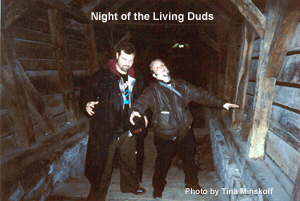 Walking through the cemetery was an incredible experience. Many of the tombstones we saw were quite well preserved, almost unnaturally so. From what I could tell, this stemmed from the treatment they received. Family members appeared to come by from time to time and clean the tombstones, or decorate them, or even detail the engraved letters with black, gold, or red. And, since this was All Saint's Day, nearly every grave had some sort of flower or decoration on it.
Walking through the cemetery was an incredible experience. Many of the tombstones we saw were quite well preserved, almost unnaturally so. From what I could tell, this stemmed from the treatment they received. Family members appeared to come by from time to time and clean the tombstones, or decorate them, or even detail the engraved letters with black, gold, or red. And, since this was All Saint's Day, nearly every grave had some sort of flower or decoration on it.As we walked along the path, I noticed that one side of the path had been lined with stones, possibly to keep the side of the small hill in place. Then, as the flash from someone's camera briefly lit the area, I thought I saw lettering on these large stones. With a start, I realized that they weren't just stones, but were tombstones. I asked one of our group-members who had a flashlight to come over and light these stones up so we could look at them more closely. When the light was from the front, the engraving could not be seen, but, when the flashlight was held at the edge of the tombstone, suddenly, much of the engraving was visible. It was kind of like having a portable rubbing kit that didn't actually touch the surface of the tombstones. I pointed out my discovery to others in the group, including both Charles and Radu, who had never noticed that these retaining stones were actually tombstones.
We left the German Cemetery and headed back down the stairway, past the clock tower, and went to our bus. The drive to our hotel, which we called T. Rex, was short, less than fiveminutes, and most of us, especially those of us who went up and down that long staircase, were more than happy to check into our rooms, curl up on our beds, and fall asleep.
The first event of the sixth day required us to travel to the town of Sibiu. It was our plan while there to visit the massive Evangelical Church, first built in 1300 and added to many times since then. This church, with its 5-pointed tower, hosts the largest organ in all of Romania, comprising over 6,000 pipes. We were not there for a concert, though; instead, our destination lay behind the narthex of the church, for that is where the burial vaults are located. The stonework on the vault seals and on the various decorations throughout the church was amazing and beautifully preserved since it was all indoors. Two vaults there held special interest for our group. The first vault was of Prince Mihnea the Bad, one of the sons of Vlad Dracula, who was murdered just outside the church. Surprisingly, this vault cover was rather plain, with its predominant feature being a rather shallow, yet intricately carved cross.
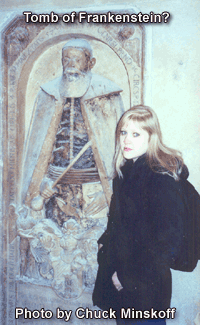 The second vault of interest was that of Valentini Frank, a Romanian scientist and physician. His cover was quite elaborately decorated with a large high relief figure of a robed and bearded man, angels, a family coat of arms, and was encircled by an inscription. The reason this vault was of interest, beyond the artistry that went into the creation of its cover, is that Valentini Frank is believed to have been used, at least in part, by Mary Shelley to create her character of Victor Frankenstein. As it was explained to us, Shelley had a number of paramours, one of whom was from Sibiu, and it was he who told Shelley about Frank's life and the various experiments he was rumored to have conducted. It was interesting to discover that the paring of Dracula and Frankenstein's Monster actually has an historical basis. This was a great stop on the trip.
The second vault of interest was that of Valentini Frank, a Romanian scientist and physician. His cover was quite elaborately decorated with a large high relief figure of a robed and bearded man, angels, a family coat of arms, and was encircled by an inscription. The reason this vault was of interest, beyond the artistry that went into the creation of its cover, is that Valentini Frank is believed to have been used, at least in part, by Mary Shelley to create her character of Victor Frankenstein. As it was explained to us, Shelley had a number of paramours, one of whom was from Sibiu, and it was he who told Shelley about Frank's life and the various experiments he was rumored to have conducted. It was interesting to discover that the paring of Dracula and Frankenstein's Monster actually has an historical basis. This was a great stop on the trip.Following our tour of the church, we were given some time to shop or eat an early lunch, which was strongly suggested since the next part of our trip would take several hours. Several people from our group made an immediate beeline for a nearby "farmacie" to look for throat lozenges and other cold relief aids. Others of us walked around, searching for a restaurant. The square in Sibiu was quite large and I was surprised that there wasn't a restaurant visible. Still, after some diligent searching, we found a place to eat and descended upon it. Knowing our time was short, we tried to order quickly, but the waitresses were remarkably inattentive. One member of our group, feeling somewhat adventurous as well as feeling the time crunch, decided to order steak tartare, thinking to himself, "What could be quicker to serve than raw beef?" He, of course, was the last one served, and his plate was a masterpiece of culinary artistic expression, which, we speculated, was why it took so long for his meal to arrive. Even with all of the delays, we weren't more than about ten minutes late. Others in the group found some amazing second-hand stores with leather jackets for sale at less than $10 each. Carly (Wednesday Addams) from our group was disappointed when a shop owner wouldnít sell her a Megadeth item on display.
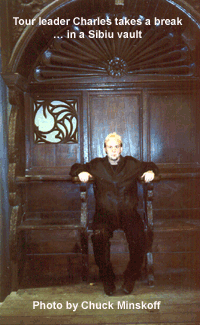 We headed north up the Arges Valley to our next stop, the Poienari Citadel, also known as Draculaís Fortress. Dracula buffs insist that this is the only true Draculaís Castle. Previous Dracula Tours had not stopped here, and even Radu, our native guide, had not been here in fifteen years. The Citadel was built in 1459 by Turkish prisoners and served as a fortress for Vlad Dracula and his family. It also provided the Romanians with a nearly unreachable point of defense in guarding the entrance to the Arges Valley. The Citadel is now in ruins; a great deal of it slid down the mountain in the late 1800s. What remains is just a shell, literally, of what used to be there, but it is still fascinating to see. When we arrived at the base, snowflakes began to fall, but disappeared quickly.
We headed north up the Arges Valley to our next stop, the Poienari Citadel, also known as Draculaís Fortress. Dracula buffs insist that this is the only true Draculaís Castle. Previous Dracula Tours had not stopped here, and even Radu, our native guide, had not been here in fifteen years. The Citadel was built in 1459 by Turkish prisoners and served as a fortress for Vlad Dracula and his family. It also provided the Romanians with a nearly unreachable point of defense in guarding the entrance to the Arges Valley. The Citadel is now in ruins; a great deal of it slid down the mountain in the late 1800s. What remains is just a shell, literally, of what used to be there, but it is still fascinating to see. When we arrived at the base, snowflakes began to fall, but disappeared quickly.Reaching the Poienari Citadel is quite a challenge. Just about the only way to reach the site is to climb a long, winding staircase. "Long" may not even be a descriptive enough term for this staircase; neither is "enormously, incredibly long." The staircase which, of course... was not there when Vlad Dracula was having the place built, is around 1,500 steps. I'm not sure why, but climbing this staircase reminded me of M.C. Escher's drawing, "Ascending and Descending." To many, it was a matter of pride to reach the top.
Several thoughts came to mind as I slowly made my way up the staircase. I marveled at the sheer effort it must have taken to build something like a fortress at the top of this mountain. According to Radu, the staircase we were on was not here when he last visited the Citadel some fifteen years previous; at that point, it was simply a path. That made the accomplishments of the Turk prisoners all the more remarkable. I can only assume that everything required to construct the Citadel was carried up there, from bricks to lumber, from mortar to iron, even food and water. And, frequently, I found myself wondering just what in the world possessed me and led me to think I could make this climb. I was certainly not in shape for such a task, but I felt that, as long as I took frequent breaks along the way, I would be fine. Ha! My leg, which had acted up climbing a mere 172 stairs in Sighisoara the previous evening, started to balk almost immediately at this latest assault on my sedentary lifestyle. Still, I pressed on, telling myself that this might be my only chance to see this site.
Less than fifty or so feet from the Citadel, I encountered one obstacle that nearly ended my trek, a wooden bridge across a rather narrow but deep chasm. I'm not a big fan of heights, and the wood boards on the bridge did not look all that solid to me. Visions of every cinematic bridge accident began to replay themselves in my mind. Fortunately, I was also reminded of the comedic line, "I don't mind falling so much; it's that sudden stop that I hate." I also knew that everyone else had crossed the bridge without incident, but there was still the chance that their passing had weakened the structure just enough... I screwed up my courage, told myself that I had not come this far up the side of this mountain just to stop here, and crossed the bridge, being very careful to step only along the steel support joists. And, with that, I was at the base of the Poienari Citadel.
Although there isn't much left of the Citadel; a hallway, one good-sized room with a doorway, a couple of turret sections, and an exterior wall along two sides. It was still an imposing, foreboding place. Most of our group walked around silently, almost respectfully, examining what remained of one of Vlad Dracula's fortresses. As in Sighisoara, I again felt a definite connection to the past. We weren't standing in a recreation of a castle; this wasn't something put here by Disney or Universal for our entertainment. This had been someone's home. People fought and died here. And now, centuries later, here we stood, in awe of their accomplishments. Seeing the Poienari Citadel was, for me, one of the absolute high points of this tour, and I hope that Charles and Danny keep a visit to it in future itineraries.
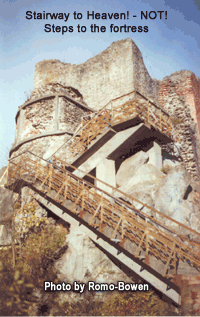 Heading down the mountain was much easier than going up it had been. But, oddly, it seemed to take longer to go down than it had to go up. As we descended, we encountered a Romanian soldier who was stationed there. Apparently, there was a hydroelectric plant nearby that this soldier was guarding. Whether he thought we were some kind of threat or not, I'll never know; personally, I think he was just bored out of his skull and saw the opportunity to have some fun at our expense. Radu and he spoke at length, and the soldier then followed us down the mountain to the bus. Several people had their picture taken with him, and he was given gifts (for not shooting us?) of cigarettes, a lighter, and a bottle of beer.
Heading down the mountain was much easier than going up it had been. But, oddly, it seemed to take longer to go down than it had to go up. As we descended, we encountered a Romanian soldier who was stationed there. Apparently, there was a hydroelectric plant nearby that this soldier was guarding. Whether he thought we were some kind of threat or not, I'll never know; personally, I think he was just bored out of his skull and saw the opportunity to have some fun at our expense. Radu and he spoke at length, and the soldier then followed us down the mountain to the bus. Several people had their picture taken with him, and he was given gifts (for not shooting us?) of cigarettes, a lighter, and a bottle of beer.Tired but invigorated, we headed from Poienari Citadel to the town of Curtea de Arges where we stayed for the night. The Hotel Posada was quite a popular spot. That evening, it was host to a group of professional soccer players and a large business convention. The restaurant in the hotel was good, if a little slow, and we were invited to wait after we had finished our dinner to attend a presentation of traditional Romanian dancing. Oddly, the dancers only performed two brief dances, one by the women in the group and one by the men, before they scurried out of the restaurant. Several of us speculated that they had another gig to get to elsewhere in town. A synth band that looked as if they time-tunneled out of the 80ís also performed. We called them 'A Flock of Gypsy Seagulls'. Their female member flirted with Philip from our tour group, but we couldnít tell if he was flattered or flustered. After dinner, one of our more quiet travelers, Alan, took off his shirt to show us his amazing Godzilla tattoo.
Some members of the group actually had the energy go and check out the nightlife. I was told there wasnít much going on and they all ended up at 'the' local bar. The story is that when they walked in everyone stopped what they were doing and stared (just like when a stranger enters any pub in a vampire film looking for directions to 'the castle'). The residents of the town didnít like strangers and ignored our group as best they could. But this wasnít any group, this was the Dracula Tour group and they didnít leave until they had their fill of spirits. Apparently, that took a long time because the service was so slow, and knowing that they werenít welcome only made them more determined to impale the locals with their presence. For this I salute The Tourists of Terror.
On our penultimate day in Romania, we boarded the bus and headed back to Bucharest for our final day of activities. By this point in the tour, many of us had come down with a cold or sore throat and, collectively, our energy was down. What better way, then, to liven up folks on a Dracula Tour than with an impromptu tour of a cemetery? A few kilometers outside of Curtea de Arges, we stopped and went into a small roadside cemetery. A chapel stood at the back of the cemetery, and a number of locals were in attendance, paying their respects to their departed loved ones. As we had seen elsewhere, flowers had been placed on most every grave. Many tombstones had a small opening at their base, or a small metal box attached somewhere near the bottom, where lit candles could be placed. Etched photographs were common on the tombstones as well, showing the deceased when they were younger and in their prime. Some photographs were of infants and toddlers; that was sad to see.
My wife got into a conversation with an elderly woman who was standing near a grave. Even though the woman spoke no English, they were able to communicate in bits and pieces since my wife knows some French and Spanish, and she found that many words were similar to Romanian. The woman was there to honor and visit her husband who had died two years previous. I found it amazing that they were able to carry on a conversation, and I was also impressed that this woman seemingly sought out my wife as the one person with whom she could share her grief. This turned out to be one of the most special moments of the entire trip for Eileen, she was so touched. Beth had also walked up and joined them, and, together, they shared a little piece of someone else's heart and life.
As I walked back to the bus, I noticed that we had stopped quite near a roadside mile marker (or, I guess more appropriately, a kilometer marker). I had seen these all along the small, two-lane roads that had served as our main transportation arteries throughout Romania, but they had always seemed to be on the opposite side of the bus from where I was sitting and I could never get a good, clear photograph of them. I found these markers fascinating because, to me, they all looked like small tombstones. I even commented to Charles, "You know, you just gotta love a country that uses tombstones for mile markers."
Next stop: Bucharest. Radu took us on a brief driving tour of the city and pointed out a number of historic landmarks and buildings, such as the enormous Palace of Parliament, second only to the Pentagon in total surface area. He also pointed out that much of Bucharest has been rebuilt following bombings during World War II, an earthquake in 1940, and another massive earthquake in 1977. Frankly, I was amazed that any of the older buildings were standing at all.
After our whirlwind tour of Bucharest, we headed north towards Snagov Lake to our final historical destination, the Snagov Monastery. The monastery is somewhat inaccessible, as it is located on a small desolate island. The importance of this site to our tour was obvious, the Snagov Monastery is where Vlad Dracula's body is entombed.
Various stories exist about Vlad's death. Historically, Vlad Dracula was executed in 1476, his body beheaded; the head was sent off and, supposedly, the body was buried at the Snagov Monastery. The tour books state that, when Vlad's tomb was opened to exhume the body, it was found to be empty. However, the locals tell a different tale. They say that many believed that Vlad Dracula was a "strigoi," a Romanian term for spectre or ghost... or vampire. It was said that a strigoi was a creature without a soul and, before it could leave this life, it had to steal a soul from the living. If a strigoi were buried before it accomplished this task, its body would, over time, turn into a horse. As the locals explain it, when Vlad's tomb was opened, inside they found the headless remains of a horse, and the vault was quickly resealed. Whether the tales were true or not, there was certainly a documented historical connection between Vlad Dracula and the Snagov Monastery, as he had commissioned the construction of many of the buildings on the island as well as a bridge that no longer exists.
Now, the only way to reach the Snagov Monastery is by rowboat. We were ferried across to the island, four or five at a time, by one lone (albeit strong) woman who made trip after trip to get every one of us onto the island. She reminded us of the wife in the movie 'Motel Hell'. A group of little children made sure we got into the rowboats safely (editorís note: they were the same kids
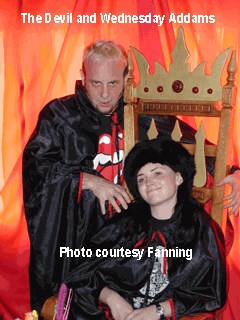 who had been with us the prior year), and we rewarded them with American Halloween candy and treats.
who had been with us the prior year), and we rewarded them with American Halloween candy and treats.The monastery itself consists of several brick buildings, plus a smaller house with a fenced-in area for various livestock. The exterior of the main monastery building has recently been restored, and is a wonderful-looking construction of brick and mortar. The interior, wherein Vlad's tomb resides, is still being restored and a great deal of scaffolding has been erected to allow artisans to work on the elaborate paintings and frescoes that cover the walls.
Vlad's tomb was surprisingly plain, looking basically like a poured concrete slab in the floor. A framed painting of Vlad that sat atop this slab served as the only decoration and identification for the purported contents of the tomb. Once more, that feeling of quiet awe, of connecting with history, seemed to envelop many in our group. Visiting this tomb was a proper and fitting ending to the tour, bringing the historical trail to an appropriate conclusion.
However, visiting the Snagov Monastery was not the last event planned for our tour. We had two more things to do before we flew home the next day. The first was to pay an impromptu visit to the Bucharest Mall, as many of us were still looking for various items to purchase for gifts. This was the first time we saw a part of Romania as a modern, Westernized society. There was a tattoo parlor tucked away in the corner of the mall, a casino behind the video arcade and typical retail shops like Spencer & Marks, Benneton and Foot Locker-ish stores. Alas, there was no Hot Topic. Malls are pretty much universal entities, and this one was no different, but it did allow us to see a more contemporary Romania and its people.
Our last scheduled event of the tour was a dinner at the Dracula Club restaurant. The restaurant was a short walk from our hotel, the Grand Boulevard, a wonderful example of European Old-World elegance. To gain entrance to the restaurant, we rang the bell suspended outside the locked front door. After a moment, a small window in the door opened, Radu announced us, and the door then slid aside, allowing us to enter. All of the dining rooms on the first story had been reserved for our group. The dining rooms were decorated in the European lodge tradition of stuffed and mounted wildlife, although the number of animals lining the walls was pretty extreme. The molding along the top of the walls was also decorated with various dried plants and other, less identifiable items.
As we were beginning to enjoy our appetizers, the lights suddenly went out; candles on the tables provided the only illumination. Strains of eerie music, faint at first, began to grow louder and more noticeable. Charles, who had been to the Dracula Club previously, seemed to take particular glee in warning us to "Be ready; somethingís going to happen any second now." But it would be several minutes, though, before that "something" actually occurred. Timed to a loud peal of thunder, Count Dracula made an appearance into our dining room, stepping quickly in from the darkness of the stairwell. He had been coached somewhat on his lines, but he could have learned several pointers from our group. For example, he did recite the classic line, "Listen to them, the children of the night; what music they make," in response to some howling wolves on the music track. However, when offered something to drink from one of the tables, he did not reply with, "I never drink... wine". He looked like a cross (pardon the word 'cross') between Christopher Lee and Count Yorga.
After he spoke to our group for a few minutes, he took Tina the newlywed by the hand and pulled her to her feet. Then, throwing his cape over her shoulders, he led her downstairs. A number of us followed them down to the lower level of the restaurant and watched as they crossed a narrow catwalk to a small room on the far side of the restaurant where Dracula then proceeded to "bite" Tina. He released her a moment later and she returned to the waiting arms of her new husband, Chuck. Dracula then came back and posed for some photographs, turning his back to us at one point to put in his fangs. We returned to our dining rooms upstairs and finished our meal.
Following dinner, I ventured back downstairs to take some more pictures and to explore a bit. The stairwell leading to the lower level was lined with Dracula movie memorabilia, from photographs from various films to what appeared to be actual movie props. In fact, coming out of the wall appeared to be a figure emerging from the brick; the figure was either made from molds used for "Bram Stoker's Dracula" or it was a tremendous replica. There were several levels in the basement; one area resembled a pit, while another area looked something like a loft. The decorations in the basement would have made Tomas de Torquemada or the Marquis de Sade feel quite at home, there were numerous iron torture implements on display, as well as a plethora of preserved animal skulls.
After dinner, some of us headed back to the hotel. The rooms of The Grand Boulevard Hotel were very elegant and definitely the best of the entire trip. We had a long day ahead of us so it was nice to sleep in a comfortable bed. Others members of the group were true creatures of the night and went out to explore Bucharest and itís nightlife. I heard various stories the next morning -- it seemed that everyone, no matter what they did, had a great time. A few members did a little casino hopping, and although none came back with vast fortunes, the memories of losing oneís cash in Bucharest must be priceless. One larger group went to a nearby bar/dance club where the meeting ritual is somewhat different. In Bucharest, people line up around the dance floor and display themselves like peacocks. It seemed weird to everyone in the group at first but after a few drinks Iím told it was fun. The newlyweds, Chuck and Tina, opted to go to a very ritzy (for Bucharest) nightclub. The same dancing/posing ritual went on, and the competition amongst the women was fierce. There were about 10 girls to every one man so they all did there best moves (mostly shaking their butts very fast) to attract them. Tina said she was afraid to leave Chuck alone to go to the bathroom, afraid he might be smothered to death by a flock of nubiles in spandex.
Our last morning in Romania found us tired, dragging, eager to get home, but still sad to be leaving. Doing the things we'd done and seeing the sights we'd seen had worn us out, to be certain, but it had also primed us to want more. A week was simply not enough time to explore the homeland of Vlad Dracula and partake of all that this land had to offer to us.
The previous Sunday, we began our journey as a group of strangers who happened to share, to varying degrees, a common interest. By our first morning in Romania, we were on our way to becoming friends. And, later that night, we had bonded into a group, a family. Charles had commented that it has been his experience that the people on every tour do at some point bond into a group, and that ours had done so faster than any other group. I'm proud to have been a part of that.
Once in New York, we made our way through Customs once more and through U.S. Immigration. Even though we were all getting ready to head back to our own lives in places all over the country, the one phrase I did not hear spoken frequently was "Good bye." Instead, I heard a lot of things like "It was great to meet you," "We'll see you soon," and "Please stay in touch." People were sharing hugs and hearty handshakes with each other, not as strangers or even acquaintances do, but as friends and family do. Wishing our departing friends a safe trip home, I found myself marveling at just how close we had all become. And that, I believe, is the best possible compliment I could extend to Charles and Danny on this tour.
We walked outside the terminal and made our way to the taxi stand. It was raining then, with a very strong wind. "So," Eileen said, "have you given any thought to how you're going to start out your tour write-up?" I looked out at the swirling clouds and the rain being driven against the buildings, and a sly, impish grin spread across my face. "Yeah," I said, "it was a dark and stormy night..."
|
|
||

|
 |
|
Copyright © International Tours & Events LLC. All rights reserved







